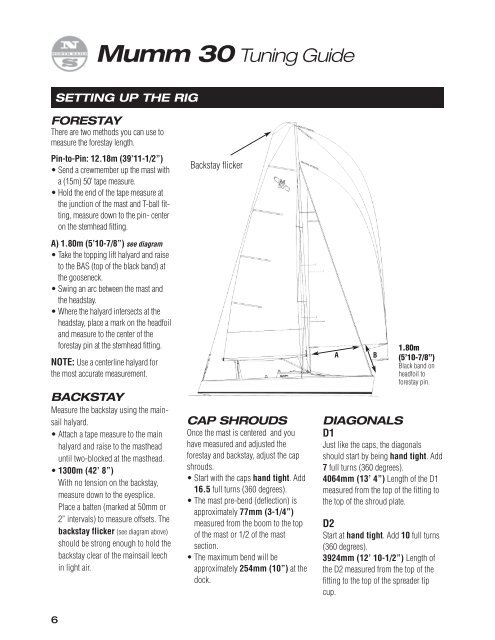You also want an ePaper? Increase the reach of your titles
YUMPU automatically turns print PDFs into web optimized ePapers that Google loves.
6<br />
<strong>Mumm</strong> <strong>30</strong> <strong>Tuning</strong> <strong>Guide</strong><br />
SETTING UP THE RIG<br />
FORESTAY<br />
There are two methods you can use to<br />
measure the forestay length.<br />
Pin-to-Pin: 12.18m (39’11-1/2”)<br />
• Send a crewmember up the mast with<br />
a (15m) 50’ tape measure.<br />
• Hold the end of the tape measure at<br />
the junction of the mast and T-ball fitting,<br />
measure down to the pin- center<br />
on the stemhead fitting.<br />
A) 1.80m (5’10-7/8”) see diagram<br />
• Take the topping lift halyard and raise<br />
to the BAS (top of the black band) at<br />
the gooseneck.<br />
• Swing an arc between the mast and<br />
the headstay.<br />
• Where the halyard intersects at the<br />
headstay, place a mark on the headfoil<br />
and measure to the center of the<br />
forestay pin at the stemhead fitting.<br />
NOTE: Use a centerline halyard for<br />
the most accurate measurement.<br />
BACKSTAY<br />
Measure the backstay using the mainsail<br />
halyard.<br />
• Attach a tape measure to the main<br />
halyard and raise to the masthead<br />
until two-blocked at the masthead.<br />
• 1<strong>30</strong>0m (42’ 8”)<br />
With no tension on the backstay,<br />
measure down to the eyesplice.<br />
Place a batten (marked at 50mm or<br />
2” intervals) to measure offsets. The<br />
backstay flicker (see diagram above)<br />
should be strong enough to hold the<br />
backstay clear of the mainsail leech<br />
in light air.<br />
Backstay flicker<br />
CAP SHROUDS<br />
Once the mast is centered and you<br />
have measured and adjusted the<br />
forestay and backstay, adjust the cap<br />
shrouds.<br />
• Start with the caps hand tight. Add<br />
16.5 full turns (<strong>36</strong>0 degrees).<br />
• The mast pre-bend (deflection) is<br />
approximately 77mm (3-1/4”)<br />
measured from the boom to the top<br />
of the mast or 1/2 of the mast<br />
section.<br />
• The maximum bend will be<br />
approximately 254mm (10”) at the<br />
dock.<br />
A B<br />
1.80m<br />
(5’10-7/8”)<br />
Black band on<br />
headfoil to<br />
forestay pin.<br />
DIAGONALS<br />
D1<br />
Just like the caps, the diagonals<br />
should start by being hand tight. Add<br />
7 full turns (<strong>36</strong>0 degrees).<br />
4064mm (13’ 4”) Length of the D1<br />
measured from the top of the fitting to<br />
the top of the shroud plate.<br />
D2<br />
Start at hand tight. Add 10 full turns<br />
(<strong>36</strong>0 degrees).<br />
3924mm (12’ 10-1/2”) Length of<br />
the D2 measured from the top of the<br />
fitting to the top of the spreader tip<br />
cup.

















